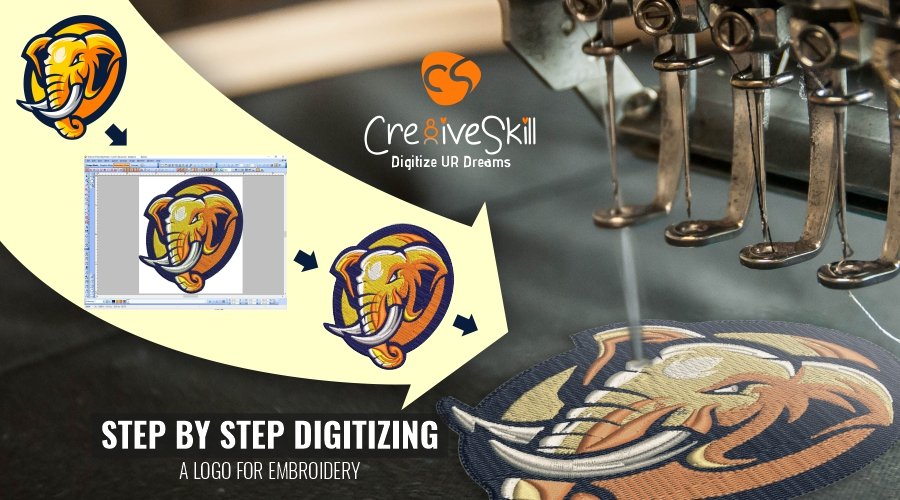Understanding the Needlework Digitizing Refine: Your Ultimate Overview
Needlework digitizing is a thorough craft that needs accuracy and experience to convert elaborate styles right into electronic styles for machine needlework. As artisans start this trip to understand the needlework digitizing procedure, a detailed understanding of the basics sets the structure for quality. Nonetheless, beyond the simple understanding lies a realm of innovative software program, specialized tools, and nuanced methods waiting to be checked out. By delving into the nuances of digitizing, one can unlock a world of innovative possibilities and raise their embroidery jobs to new heights.

Recognizing Needlework Digitizing Essentials
Needlework digitizing fundamentals develop the foundation upon which elaborate designs are equated right into machine-readable styles for accurate stitching. This initial step in the embroidery digitizing procedure is critical for ensuring that the last stitched product is a faithful representation of the original design. Understanding needlework digitizing essentials includes comprehending essential concepts such as stitch types, sew instructions, density, underlay, and draw payment.
Stitch types play an essential duty in figuring out the visual and textural outcome of the stitched style. By selecting the ideal stitch kind, whether it be satin, fill, or running stitch, digitizers can achieve the wanted result and improve the overall quality of the embroidery. Additionally, sew instructions influences the circulation and dimension of the design, while thickness identifies the spacing and coverage of the stitches.
In addition, rug stitching supplies stability to the style by securing the textile and stopping distortion during the needlework process. Draw compensation is an additional important factor to consider to combat the all-natural tendency of textile to contract when sewn. Mastering these embroidery digitizing essentials is essential for creating professional-quality embroidered items.
Picking the Right Digitizing Software
Choosing the proper digitizing software is a vital choice that dramatically impacts the efficiency and high quality of the needlework digitizing procedure. Digitizing for Embroidery. When picking the appropriate digitizing software, it is vital to take into consideration variables such as the intricacy of designs you plan to create, the user-friendliness of the software, the level of client support provided, and the compatibility with your embroidery maker
There are different digitizing software application choices readily available in the marketplace, varying from standard programs for newbies to innovative software program for specialist digitizers. Some prominent choices include Wilcom EmbroideryStudio, Hatch Embroidery Software, and PulseID. These software supply a large range of devices and functions to assist you create intricate designs easily.
Before choosing, it is recommended to explore the different software application alternatives via complimentary trials or demos to determine which one ideal fits your requirements. Additionally, reviewing evaluations and seeking referrals from seasoned digitizers can supply important understandings right into the strengths and weak points of each software application package (Digitizing for Embroidery). By carefully reviewing your demands and contrasting the functions of different digitizing software application, you can make an informed selection that improves your needlework digitizing process
Digitizing Devices and Methods

Optimizing Design Settings for Needlework
Mastering the complexities of design settings is fundamental in achieving optimal cause the embroidery digitizing procedure, building upon the foundation laid by understanding digitizing devices and strategies. When enhancing style settings for needlework, it is necessary to take into consideration variables such as stitch kind, density, underlay, draw payment, and enrollment. Sew type selection influences the general feel and look of the layout, with choices like satin, fill, and running stitches offering various structures and effects. Thickness describes the spacing and thickness of stitches, influencing the style's coverage and durability. Correct rug stitching gives stability and prevents textile distortion, particularly for intricate styles or on stretchy products. Pull settlement adjusts for textile stretch during sewing, ensuring exact style replication. Enrollment settings line up various aspects of the layout precisely, maintaining general layout stability. By fine-tuning these layout settings, embroiderers can boost the quality and accuracy of their stitched developments.

Troubleshooting Common Digitizing Issues
When experiencing usual digitizing issues during the needlework procedure, it is vital to recognize the root triggers and apply effective options without delay. One common trouble is stitch YOURURL.com density problems, where stitches might be also thick, causing the material to tighten, or also sparse, resulting in spaces in the layout. Readjusting the stitch thickness settings in the digitizing software can assist settle this issue.
Another regular difficulty is string breaks throughout the needlework procedure. This can occur due to various reasons such as inaccurate tension settings, boring needles, or utilizing low-grade string. Making certain correct upkeep of the needlework machine, including routine needle modifications and tension modifications, can reduce the incident of thread breaks.
Furthermore, style registration errors can result in misaligned elements within the embroidery design. Checking the design placement in the digitizing software program and making necessary look at this website adjustments before sewing can aid in preventing this problem. By addressing these usual digitizing concerns promptly and successfully, you can guarantee a smoother embroidery process and top quality finished items.
Verdict
To conclude, grasping the embroidery digitizing process requires a strong understanding of the fundamentals, the best choice of software, and expertise of tools and techniques. Maximizing style settings and repairing typical digitizing issues are critical actions in guaranteeing top quality needlework results. By complying with these steps vigilantly, one can achieve accuracy and performance in the digitizing procedure.